|
egy.com suggests following articles
|
|
Several of my articles on Garden City were plagiarized word for word by novelist MEKKAWI SAID (winner of the Egyptian State price for literature!!!!) and re-published under his own name in a three-part series in El-Masry El-Youm daily in September 2015. Cheers to our "talented" literature prize awardee. Your pain his gain !!!
|
EGY.COM - ZAMALEK
THE GEZIRA PALACE
a.k.a. Marriott Hotel
|
by Samir Raafat
Cairo Times, 14 October 1999
extended version in "The Egyptian Bourse" published by Zeitouna 2010
|
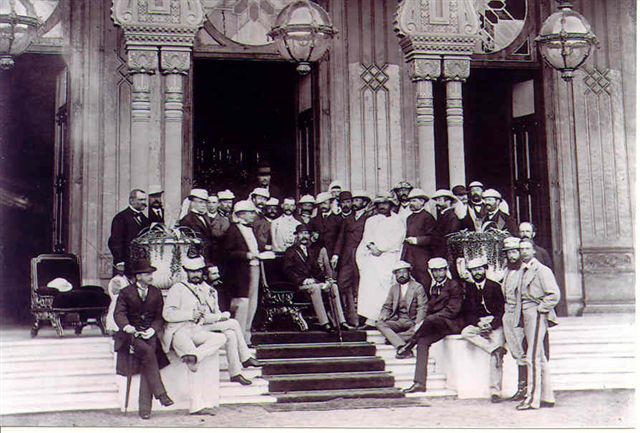
above: Emperor Franz Josef with retinue at Gezira Palace Veranda on 22 Nov. 1869; below: Gezira Palace. Photos by Augusto Beato.
(source: Austrian National Library, Photo-Collection, BS 2723-F(R) and Austrian State Archive, Vienna, papers of Baron Braun, box 20; courtesy Dr.
Rudolf Agstner)
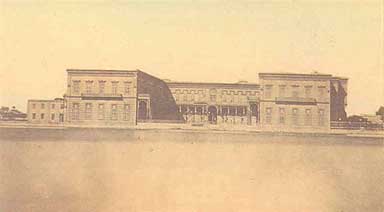

|
|
GEZIRAH PALACE SALE TIMELINE
- In 1890 the Gezirah Palace and its annexes occupied most of central Zamalek just north of the Gezirah Sporting Club. Its gardens reached what we know today as "Hadiket al-Asmaak' or Fish Garden.
- On 31 December 1889 Ismail Pasha, former Khedive of Egypt, and his three wives sell Gezirah Palace and its annexes and park to Paul Draneht Pasha and Commander Oblieght. The sale was subsequently registered in the Alexandria Mixed Courts on 25 January 1890.
- The Societe du Domaine de Ghezireh (Gezirah Land Company) created and registered in France at the Quarantennais notary office in Paris on 15 October 1892.
- On same date and at above notary office, Draneht Pasha and Commander Oblieght transfer Gezirah Palace estate assets to the Gezirah Land Company.
- On 29 June 1893 the Egyptian government cedes to the Gezira Land Company the Nile foreshore fronting the Gezirah Palace.
- On 23 March 1897 the Gezriah Land Company merges with the Egyptian Hotels Company. Merger registered on 10 April of that year.
- Egyptian Hotels Company increases its real estate holdings on the island by purchasing property contiguous to the Gezirah Palace Hotel belonging to Ambroise Zervudachi on 25 October 1898.
- The Egyptian Hotels Company again increases its real estate holdings on the island by purchasing property contiguous to the Gezirah Palace Hotel belonging to J.J. Hug & Co. on 11 May 1898.
- After resale of part of the Gezirah Palace gardens for urban development remaining property of the Egyptian Hotels Company on the island amounts to 62,750 sq.m.
- On 10 December 1919 the Egyptian Hotels Company sells its Gezirah Island assets (hotel + annexes) to Habib Lotfallah for the amount of LE 115,000 payable over three installments: LE 70,000 cash at signing and the remainder to be paid out in two installments thereafter.
- Sale conducted through Maitre George Nassif representing Lotfallah Pasha and Mr. Flood acting director of the Egyptian Hotels Company representing the latter. The broker for the transaction was Engineer Hugo Schummacher of No. 2 Chawarby Street. His commission: LE 4,800.
- Salamlik goes up in flames on 31 May 1955 while hosting tourism art exhibition.
|
KHEDIVIAL PALACE
The building's early history has become a well-worn cliché: 'the palace was hastilly built by Khedive Ismail to host Empress Eugenie during the September 1869 celebrations marking the opening of the Suez Canal.' What is not mentioned is that the Prince and Princess of Wales, on a tour of the British Empire, stayed at the Gezira Palace in March of that year.
Another royal visitor was Emperor Franz-Josef of Austria-Hungary who arrived in November 1989, with a retinue of 40 courtiers causing several protocol problems as to who got which rooms in which palace wing!
An often forgotten milestone in the palace history is that a few years after the lavish Suez festivities, the palace became one of the venues of the highly publicized khedivial nuptials, when Khedive Ismail simultaneously married off three of his sons. The spectacular wedding celebrations lasted all of 40 days.
It took several years to build the Gezira Palace with the involvement of different architects at various construction phases. It is widely recognized that the project's principal architect was the Germanic Julius Frantz Pasha (1831-1915) who, at one time, occupied the post of chief court architect. But in truth the making of the Gezira Palace brought together a collection of engineers, artists and craftsmen from different nationalities: German (Schmidt, Von Diebitsch, Frantz Pasha), Italian (Pietro Avoscani who designed the escalier d'honneur in Carara marble), French etc..
The 'hasty construction' alluded to by several writers could however apply to the section meant to accommodate the khedive's imperial guests and completed in 1869. Assisting Frantz Pasha in some aspects of this particular subdivision, was the Italian architect Del Rosso. Other parts of the Gezira Palace complex were meted out to different architects.
Like most of the khedivial palaces, the original Gezira Palace consisted of a haramlik and a salamlik along with several annexes and ornamental kiosks. The extant building overlooking the Nile, sometimes described in period books as palais des fetes, today houses the Marriott Hotel's reception, Casino, and function rooms. Denuded from its external metal trimmings and porticoes, this section of the old Gezira Palace compound could have passed as an ordinary u-shaped, almost rectangular casern-like building. It was Carl von Diebitsch who supervised the importation of the decorative, and in some sections, load bearing porticoes, from the Lauchhammer foundry in Germany. To him we owe the elegance of the building as it stands today.
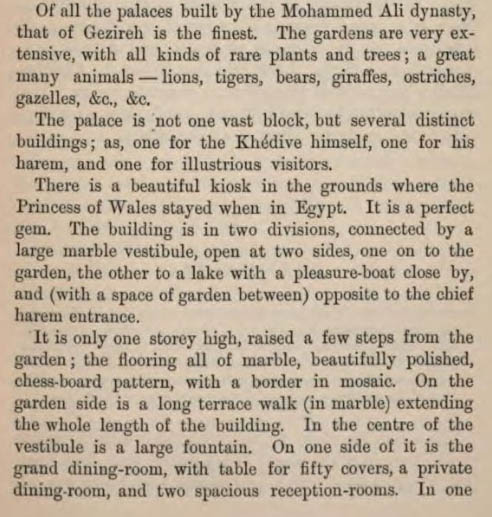
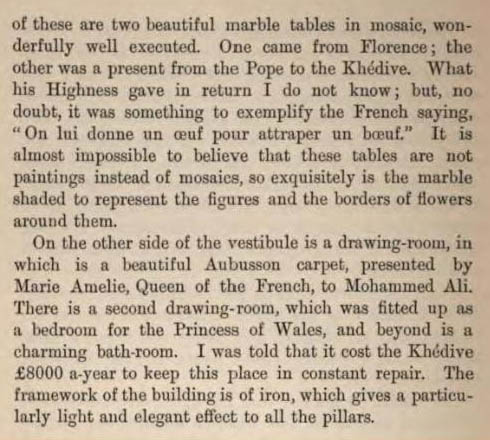
Gezira Palace as described in 1873 by Ellen Chennels the English governess to Princess Zeyneb Ismail in her book Recollections of an Egyptian Princess
The haramlik buildings where located on the site where the two Baehler Mansions are located today, on 26 of July Street.
For a detailed description of the magnificent Gezirah Gardens one has to consult the volume written by Gustave Delchevalerie on the subject Les
Promenades et les Jardins du Caire (1899).
As Khedive Ismail's chief landscaper, Delchevalerie was ultimately responsible for the Viceregal and public gardens as well as several graceful boulevards. He recounts how, on the 600-acre Gezirah island, over 1 million exotic species were planted in what amounted to an experimental nursery, subdivided into large square-shaped sections for different categories of plants: fruits (citrus and tropical), ornament, woods, windbreakers, vegetables etc. As for the private palace gardens then-covering a surface area of 20 acres (feddans), a variety of plants and trees were planted between 1868-9. When describing the royal park, Delchevalerie mentions oriental kiosks "not unlike those of Alhambra in Spain. And somewhere in between there is that magnificent marble fountain with the statue of Osiris at its center."
Delchevalerie also describes a wooded Albizzia Lebbek alley, so thick that you could no longer see the sun's rays. But the showstopper was the rocher (rock hill). "Situated near the palace, it was created and designed by Mr. Sipoz from Turkey. Underneath the rocher are passages converging on a central pavilion with wooden armchairs and benches. Water cascading down the rocher feed into a small rivulet, which winds about until it reaches a lake situated north of the palace. A tributary from that lake traverses the garden and contours the Salamlik to eventually abut into yet another lake south of the palace.
The salamlik is described by Delchevalerie as a monumental Kiosk reproducing those of Alhambra in Spain. "It was designed by court architect Mr. Schmidt. It is over 100 meters in length surrounded by beautiful Arab-style poles. At the center is a large open-air hall with marble floorings. At the hall's center, supported by pillars, is an enormous fountain. In one of the Salamlik's two wings are elaborately furnished salons and a superb dining hall where Khedive Ismail entertained, during spring 1869, the Prince and Princess of Wales. On that occasion, a firework display was offered to the royal guests and the park was aglow with a variety of lighting including 'Bengal flames,' Venetian lanterns and colored lamps strung from tree to tree along the pathways."
The salamlik's annex not described by Delchevalerie would much later become Casino El Gezira before being transformed temporarily into the daira --offices of the Lotfallah family. On Tuesday, 31 May 1955, on the eve of an International Touristic Art Exhibition expected to take place therein, the Kiosk was gutted by fire. Years later the site became home to All Saints Cathedral and the British International School.
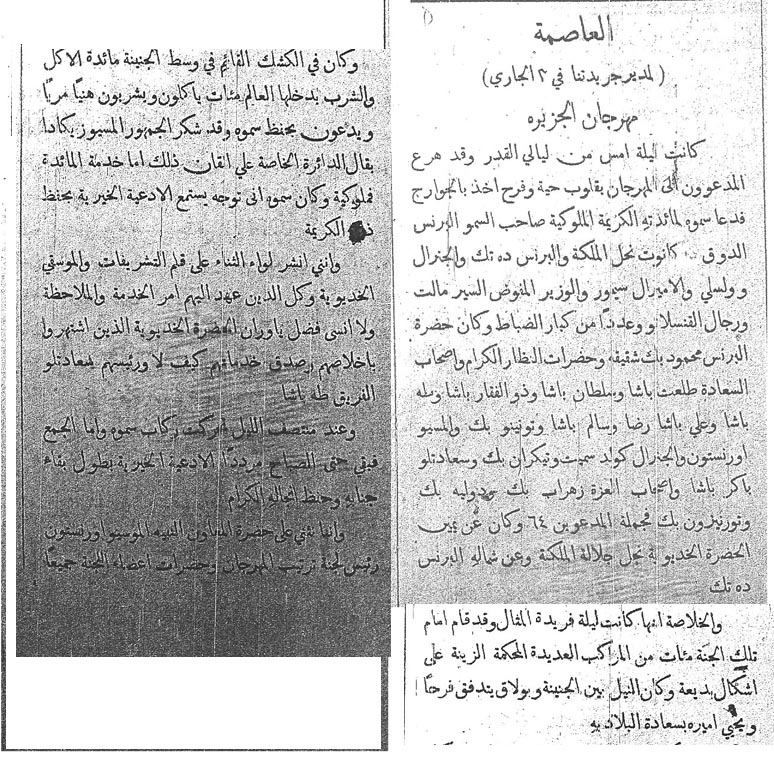
al-Ahram 4 October 1882 describing reception honoring Queen Victoria's son and General Garnet Wolseley
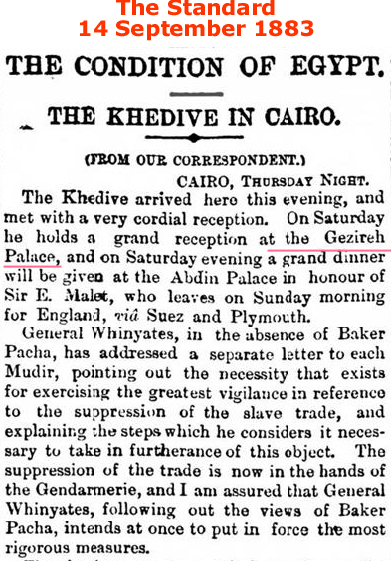
Following Ismail's exile in 1879, the palace was temporarily appropriated by the state in lieu of the monarch's outstanding debts only to be returned to its owner whilst in exile. We also find that Ismail's son, Khedive Mohammed Tewfik, often used the palace for official receptions. One of these was in honor of Queen Victoria's son the Duke of Conought. Accompanying HRH was the Prince of Teck and Sir-General Wolseley. The latter had just defeated Orabi Pasha a few weeks earlier at the battle of Tel al-Kebir thus heralding a 65 year British military occupation of Egypt.
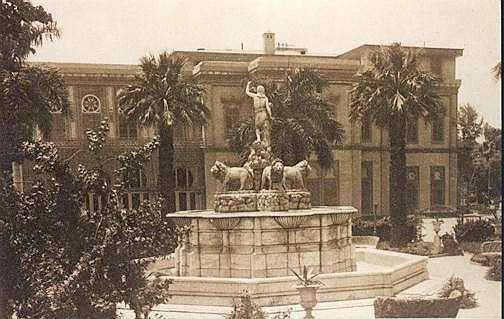
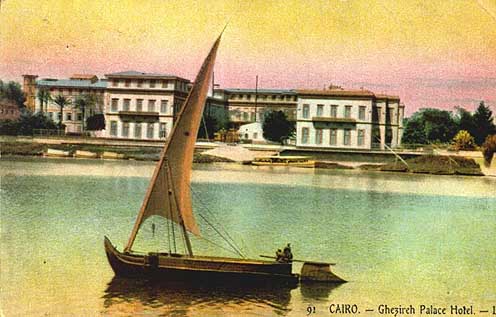
Gezireh Palace Hotel in 1909
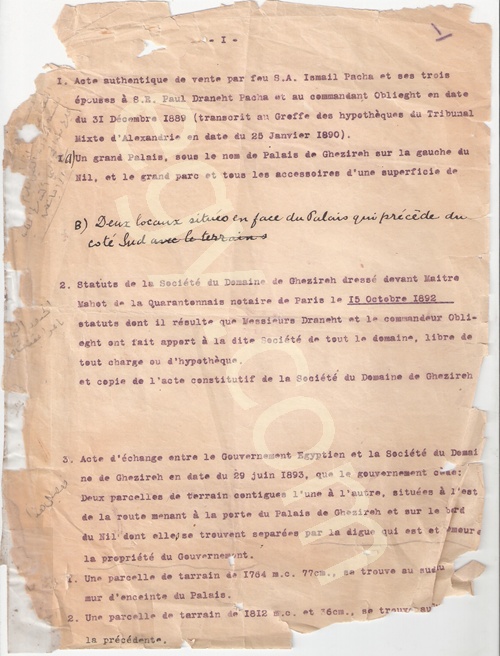
part of document evidencing sale of Gezira Palace to Draneht Pasha and others
THE GREEK PASHA
The first private owners of the Gezira Palace were Paul "Pavlos" Draneht Pasha and Commander Ernesto Emanuele Oblieght.
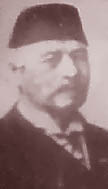 A quick-witted man, Draneht made his colossal fortune in Egypt where he started off as a chemist during the reign of Viceroy Said Pasha. The pasha later appointed his director of traffic and railways between January 1861 and November 1862. It was during the reign of Ismail Pasha h owever that Draneht became superintendent of state theatres at a monthly salary of 833 French Francs. It was in this capacity that he dealt directly with Italian composer Guiseppe Verdi during the making of Aida. Aside an extensive correspondence on the subject, according to a farfetched legend, printed in contemporary tourist brochures promoting Lake Maggiore, Verdi had allegedly sought artistic inspiration at Draneht's villa overlooking the lake at Oggebbio not far from the Italo-Swiss border. Despite his meteoric rise and multiple titles, Draneht's claim to fame would be as the first director of the new Khedivial Theatre (Opera House) a post he kept until 1879. His portrait hangs on Cairo Opera's wall of fame to this day.
A quick-witted man, Draneht made his colossal fortune in Egypt where he started off as a chemist during the reign of Viceroy Said Pasha. The pasha later appointed his director of traffic and railways between January 1861 and November 1862. It was during the reign of Ismail Pasha h owever that Draneht became superintendent of state theatres at a monthly salary of 833 French Francs. It was in this capacity that he dealt directly with Italian composer Guiseppe Verdi during the making of Aida. Aside an extensive correspondence on the subject, according to a farfetched legend, printed in contemporary tourist brochures promoting Lake Maggiore, Verdi had allegedly sought artistic inspiration at Draneht's villa overlooking the lake at Oggebbio not far from the Italo-Swiss border. Despite his meteoric rise and multiple titles, Draneht's claim to fame would be as the first director of the new Khedivial Theatre (Opera House) a post he kept until 1879. His portrait hangs on Cairo Opera's wall of fame to this day.
In April 1877 Draneht received the title of pasha with the added responsibility of managing the vast Daira Maia agricutural estate.
The indulgent father of a two-year-old daughter, Draneht Pasha retired to Europe at age 62 a very rich man. It was now up to his Daira (office) in Egypt to handle his private and financial affairs. In 1901, a few years after Draneht's death, the Daira incorporated itself in the Societe des Domaines de la Daira Draneht Pasha with a capital of LE 440,000. These were among the most fertile in Lower Egypt so much so that in January 1901, Khedive Abbas Hilmi sought to purchase 12,000 feddans at Kafr al-Dawaar belonging to the said Daira.
Draneht Pasha's name would later on be associated with a mango specie "Draneeta" produced on his vast estate near Abou Hommos in Egypt's Delta province of Behera. Yet according to one of his descendants the family surname was itself an invention by its owner. Perhaps betraying his penchant for theatrics Pavlides, an Ottoman subject who hailed from Cyprus, had been sent on an Egyptian state scholarship to study at the Sorbonne in Paris. It was there that he decided to adopt his French professor's (Louis Jacques Thenard) surname spelling it backwards hence 'Thenard' became 'Draneht'.
If Draneht Pasha's wealthy daughter married into the well-known Alexandrian-Greek family of Zervoudachi, his descendants in turn would become related through marriage to the first industrial family of Italy the Agnellis hence perhaps the reason why part of Draneht's descendants today live in the North of Italy and Switzerland.
The Hungarian-born Commander Oblieght on the other hand had made his mark as early as 1880 by introducing the funicular (train) that climbed Italy's Mount Vesuvius.
Almost two years after the purchase of the Gezira Palace by Draneht Pasha and Commander Oblieght, the Societe du Domaine de Ghezireh was formed in 1892 with the purpose of starting several urban development projects on the island. Hence the parceling out of part of the palace park for the creation of he Gezirah Gardens residential district. This is the area that today covers the land between the Marriott Hotel and the Fish Garden.
SWISS HOSPITALITY CZAR
But even before the Gezira Land Company was fomally taken over by the Egyptian Hotels Company Ltd. (EHC) in 1897, the palace had already begun operating as the Gezira Palace Hotel becoming world famous under the expert management of Swiss Hospitality Czar Charles Baehler.
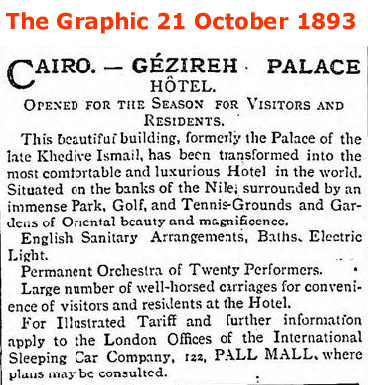
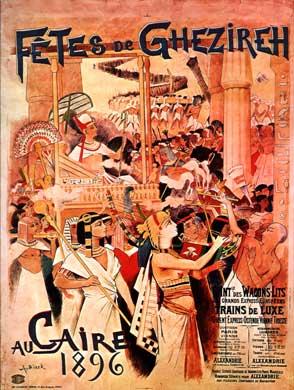
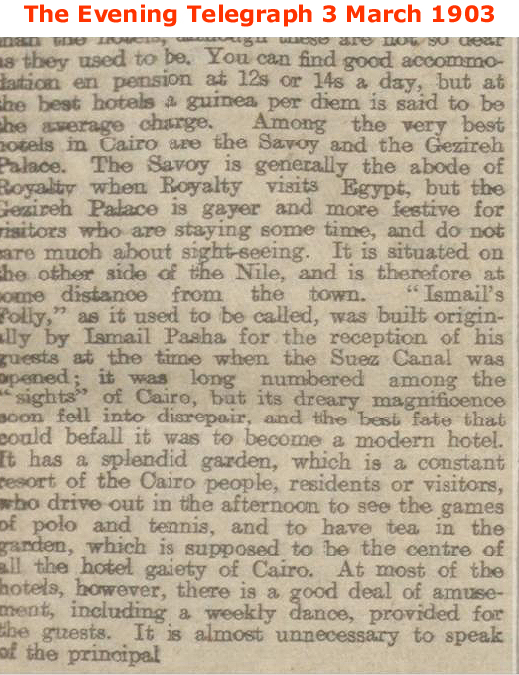
The historic resolution to auction the Gezira Palace Hotel took place on 30 October 1919, during the Egyptian Hotel Company's twenty-second annual board meeting in London. The incumbent directors knew better than to go against a recommendation put forward by Monsieur Charles Baehler, Egypt's undisputed hospitality czar.

Baehler's career begun in 1889 when as a junior employee, he joined the legendary Shepheards Hotel. Within a few years, the Swiss accountant from Thoune became general manager of the EHC, the then-largest hotel group south of the Mediterranean. Likewise, he was looked upon as the ultimate authority when it came to tourism.
Baehler's empire included both the Egyptian Hotels Company and its sister firm the Upper Egyptian Hotels Co. Ltd. The two companies combined owned or operated most of the country's hospitality palaces. In Aswan the Cataract; in Luxor, the Winter Palace; in Cairo, the Shepheards, the Mena House, the Semiramis and the Gezira Palace; and in Alexandria, the San Stefano. The Cosmopolitan Hotel in downtown Cairo and Jerusalem's King David would appear in 1929 and 1930 respectively.
The Gezira Palace Hotel thrived on an exclusive composite of European aristocracy, adventure-seeking travelers and authors such as Agatha Christie (she and her mother spent three months at the Gezira Palace Hotel in 1910) looking for peace and quiet. To keep up with its clientele the management periodically rejuvenated the palace adding staterooms and bathrooms, expanding public areas, and refurbishing apartments located in the Haramlik section
so that guests wanting to remain after the hotel closed down for the long summer season could do so in opulent comfort.
From a November 1903 newspaper clipping we learn that the Gezira Palace had just "completed major renovations and improvements." These included the refurbishing of 80 bedrooms, the rearrangement of the Grand Restaurant and the remodeling of the billiard room and bar. Moreover, a fence was put up around the entire perimeter of the garden to ensure some privacy.
In the same year improvements were made to the steam ferry service from the hotel to the eastern bank of the Nile where one linked up with the tramway network. The ferry service was discontinued in July 1912, when the Abou al-Ela Bridge was inaugurated.
WW1 (1914-18) meant a slow death for the Gezira Palace Hotel. Aside from losing many of its aristocratic habitués whose respective empires had disappeared, the entire Gezira complex was requisitioned by the state and transformed into a British military hospital. Towards the end of the war came the palace became the headquarters of the Inland Water Transport Authority and other army services before it was returned to the EHC.
Having lost five consecutive tourist seasons, the entire hotel industry was in dire straits. Which is why Baehler's decision to unload a costly company asset could not be held against him. The Gezira Palace Hotel was up for sale in 1919 which goes contrary to several publications stating that the sale took place in 1908.
THE SYRIAN EMIR
An offer of LE 140,000 (subsequently increased to 150,000) was allegedly offered by the family of Habib Lotfallah Pasha for the purchase of the Gezira Palace lock, stock and barrel. The Lotfallahs were wealthy landowners who produced several Syrian nationalist leaders, diplomats and legislators.
Seven months after the historic purchase and as a complement to his princely acquisition, on 3 June 1920 Lotfallah Pasha received from the al-Sharif (a.k.a. King) Hussein of the Hijaz the hereditary designation of Emir. Thereafter the Lotfallah descendants enjoined that they be addressed or referred to as Prince and Princess Lotfallah, a request that earned them much derision behind their back.
Not as lucky was al-Sharif Hussein who lost both title and kingdom four years later when the al-Sauds conquered Hijaz.
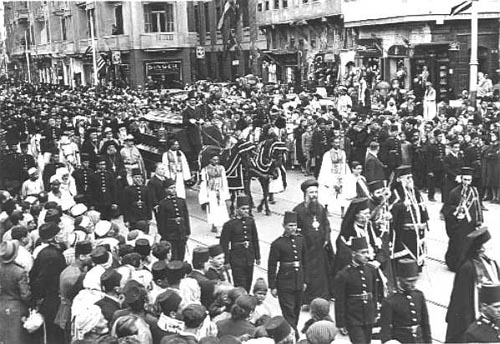
Habib Lotfallah funeral cortege
Durant la fin de son regne le roi Hussein [du Hijaz] consentait d'anoblire quinconque s'adressait a lui, pourvu que sa demande fut accompagnee de belles especes sonnantes. Ceci explique pourquoi feu Habib pacha Loutfallah, jadis Monsieur Loutfallah tout court, devint un beau jour, prince. Mais tout le monde sait qu'on nait prince. On ne le devient pas. C'est ce que les Loutfallah refuserent obstinement de comprendre.
L'egypte Nouvelle, No. 137 - 7 Fevrier 1925
|
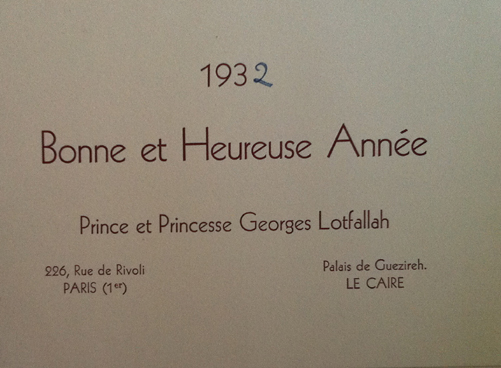
Habib Lotfallah aged 94 when the purchase of the Gezira Palace Hotel took place died within the year. However, the Emir's impressive funeral cortege attended by Cairo's notables did not depart from the palace gates of Gezira but left from the old family homestead in Fagallah.
It was now up to the Emir's descendants to enjoy their new palace along with their equivocal title. For the next 42 years, the Gezira Palace would be known as Palais Lotfallah. There was never any mention of the Khedive who built it.
During Nasser's socialist years the palace was sequestered by the state and the Lotfallahs had a year in which to move out. Two years later the palace was converted to the Omar Khayam Hotel operated by EGOTH (Egyptian General Organization for Tourism and Hotels). Wooden cabanas were planted all over the garden and a swimming pool added in part of the garden. The palace was rapidly being fleeced of its valuables--asset stripping socialist-style.
Two decades later the rat-infested and now bankrupt Omar Khayam was replaced by the Marriott Hotel.
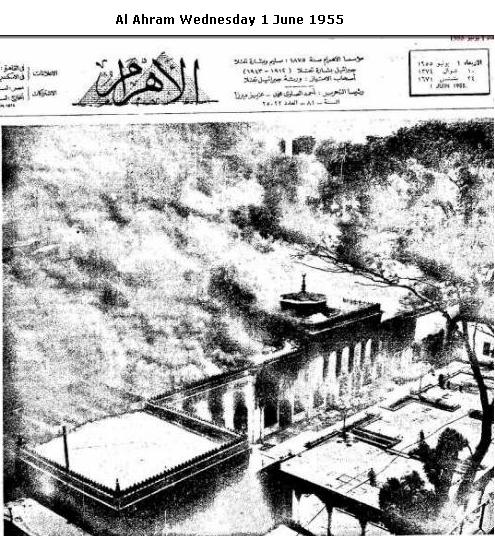
31 May 1955. Gezira Palace Salamlik (much later turned into the Lutfallah Daira) destroyed by fire while hosting an international tourism art exhibition. Site today shared between All Saints Cathedral and BISC (British International School Cairo)
Special thanks to Cici Sursock, Mila Radulovitch-Cordahi, Helga Mayringer and Lucien Toutonji.
To visit the homepage of celebrated artist Cici Sursock click on: CICI
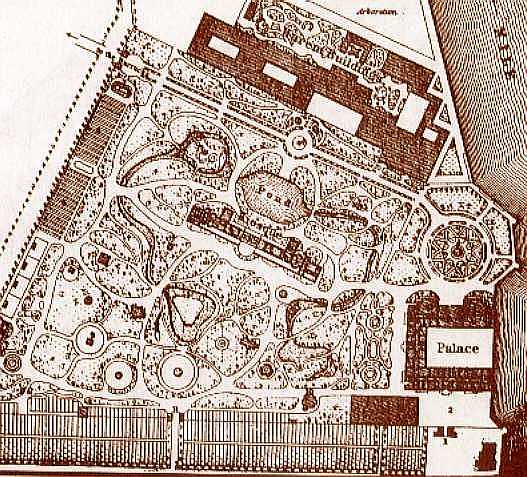

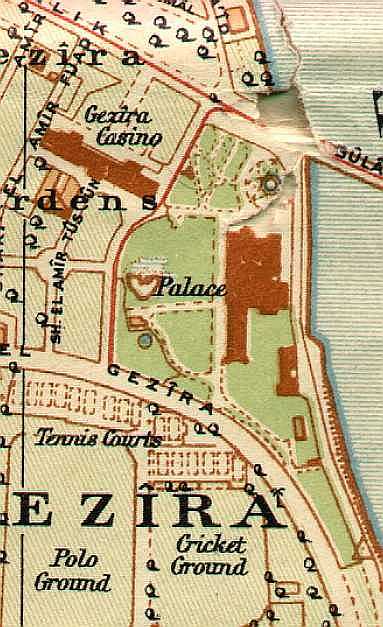
Three maps showing the development of urban Zamalek
- A lodge built for Viceroy Mohammed Ali on the island of Bulak predated the Gezira Palace.
- During September - November of that year Empress Eugenie of France and Emperor Franz-Josef of Austria also stayed there at different intervals. The emperor's 40-strong entourage were divided between the salamlik: ministers Count Frederic Ferdinand Beust, Counts Jules Andrassy, Plener and William de Tegetthoff; and the haramlik where Count Anton de Prokesch-Osten, Austria's ambassador to Constantinople, took up temporary quarters.
- Furniture imported mostly from France. Rooms used by Empress Eugenie were allegedly replicas of similar rooms in a royal palace in Paris.
- Empress Eugenie would return to Egypt in winter 1904-5 and visit the palace by now an hotel. She however stayed at the Savoy Hotel on Kasr al-Nil Street.
- Palace occupied for a time by one of the khedive's wives and her son Prince Hassan.

family trees of private owners of the Gezira Palace following its sale by Khedive Ismail

Reader Comments
|
From: Annie Lepicard
Date: Monday, February 25, 2008 7:20 PM
Subject: Au sujet de mon arriere grand-pere: Gustave Delchevalerie
Je viens vers vous car je suis Mme Annie Lepicard-Delchevalerie, arriere petite fille de Gustave Delchevalerie et je suis a la recherche de documents concernant mon aieul pendant son sejour au Caire de 1868 ŕ 1878.
Il est ne en 1841 en Belgique et mort en 1899 en France.
Il etait ancien Inspecteur des plantations au Ministere de l'Agriculture et du Commerce en Egypte. Membre de l'Institut Egyptien. Il a recu 7 distinctions honorifiques dans differents pays pour ses travaux horticoles.
J'ai deja retrouve nombreux ecrits a Paris et aupres de la famille.
J’aimerai connaitre plus precisement ses conditions de travail au Caire si cela est possible et ce qu'il a fait pour cette ville et ce pays qu'il aimait
tant. A cette epoque une rue ou avenue aurait porte son nom d'apres ma tante.
Existe-t-il encore des journaux, des documents qui relatent ses activites ?
Ou pourrai-je m'adresser?
J'ai lu avec beaucoup d'interet le document sur internet.
Je suis tres fiere de mon arriere grand-pere et je desire transmettre a mes enfants le plus d'informations sur leur ancetre.
En vous remerciant tres sincerement a l'avance de votre aide veuillez agreer, Monsieur, l'expression de mes sentiments les meilleurs.
Annie Lepicard- Delchevalerie
Adresse : 11 rue des Magnolias
78990 Elancourt
France
Mail : annie.lepicard@aliceadsl.fr
Subject: Lotfallah family tree
Date: Thu, 21 Nov 2002 02:28:27 +0000
From: anwar rahal
Please post this message on your site as I am responding to Frederique Sursock's letter posted on your website. Thank you.
Anwar Rahal
MESSAGE
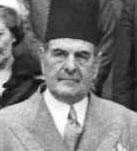
Emir Lotfallah
Hello,
My name is Anwar Rahal and I am also on the family tree of the Lotfallah and Sursock. Apparently we are cousins. I heard you are looking for some
information about the whole family. I have a whole book including pictures, about the family if that could interest you. e-mail me back so we can get in
contact. I thought it would be nice if we would get to know each other.
thanks,
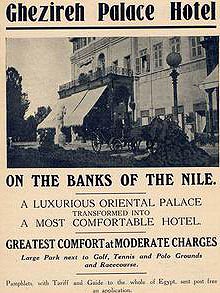
Subject: Thank you
Date: Sat, 1 Jan 2000 13:26:16 -0800 (PST)
From: Nadia Hanna
I am an Egyptian living in Montreal-Canada. When I found your website for the first time today I was very excited. Its very valuable and amazing to read
all those informations. My father a long long time ago used to work as Manager of Dayret Lotfallah when El-Amir George Lotfallah was there, and he left
after he died. You gave me the best opportunity to find out all about the previous fantastic history. Thank you. I would like to send you my best wishes
for a very happy New Millenium 2000.
The keeper of the museum of the archdiocèse of Vienna found in our national library a foto showing emperor Franz Joseph under the main portico of
Gezira Palace. I was able to date the photo as having been taken on 22 November 1869, 11:00am, by an Austrian and a Hungarian photographer living in
Cairo, Schier & Schoefft. The portico was identified by scholar Elke Pflugradt as the old Northern entrance to Gezira palace.
R.A.
Vienna
Subject: Sale of Century
Date: Mon, 19 Feb 2001 17:41:17 +0100
From: duifje
I am Frédérique Sursock. I just found myself on your page and was quite surprised I must say. I never had any real interest for the whole
family story, but now that I am having a baby in a few months I was doing some research about the history, if you have more information about the
Sursock´s and the story of the palace I would be very grateful to receive it. I noticed you have some dates of the descendants but not all of them. Do
you need them? I do have most of them. Anyhow it was an interesting article.
Ciao,
Frédérique Sursock
|
Email your thoughts to egy.com
© Copyright Samir Raafat
Any commercial use of the data and/or content is prohibited
reproduction of photos from this website strictly forbidden
touts droits reserves









 A quick-witted man, Draneht made his colossal fortune in Egypt where he started off as a chemist during the reign of Viceroy Said Pasha. The pasha later appointed his director of traffic and railways between January 1861 and November 1862. It was during the reign of Ismail Pasha h owever that Draneht became superintendent of state theatres at a monthly salary of 833 French Francs. It was in this capacity that he dealt directly with Italian composer Guiseppe Verdi during the making of Aida. Aside an extensive correspondence on the subject, according to a farfetched legend, printed in contemporary tourist brochures promoting Lake Maggiore, Verdi had allegedly sought artistic inspiration at Draneht's villa overlooking the lake at Oggebbio not far from the Italo-Swiss border. Despite his meteoric rise and multiple titles, Draneht's claim to fame would be as the first director of the new Khedivial Theatre (Opera House) a post he kept until 1879. His portrait hangs on Cairo Opera's wall of fame to this day.
A quick-witted man, Draneht made his colossal fortune in Egypt where he started off as a chemist during the reign of Viceroy Said Pasha. The pasha later appointed his director of traffic and railways between January 1861 and November 1862. It was during the reign of Ismail Pasha h owever that Draneht became superintendent of state theatres at a monthly salary of 833 French Francs. It was in this capacity that he dealt directly with Italian composer Guiseppe Verdi during the making of Aida. Aside an extensive correspondence on the subject, according to a farfetched legend, printed in contemporary tourist brochures promoting Lake Maggiore, Verdi had allegedly sought artistic inspiration at Draneht's villa overlooking the lake at Oggebbio not far from the Italo-Swiss border. Despite his meteoric rise and multiple titles, Draneht's claim to fame would be as the first director of the new Khedivial Theatre (Opera House) a post he kept until 1879. His portrait hangs on Cairo Opera's wall of fame to this day.













